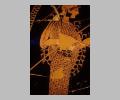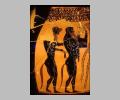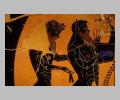| Collection: | Paris, Musée du Louvre |
| Summary: | Side A: Herakles and Cerberus (RF) |
| Ware: | Attic Bilingual |
| Painter: | Attributed to the Andokides Painter and Lysippides Painter |
| Context: | Vulci |
| Date: | ca. 520 BC - 510 BC |
| Dimensions: | H. 0.586 m |
| Primary Citation: | |
| Shape: | Amphora |
| Beazley Number: | 200011 |
| Region: | Etruria |
| Period: | Archaic |
Date Description: Mature period, only seen on the red figure halves of bilingual amphorae, type A (
Decoration Description:
Side A: Athena stands at the left extending a protective arm towards Herakles. She wears a necklace, a crested helmet with added purple details (which projects up into the ornamental band), elaborately patterned chiton with long sleeves and aegis framed with interlaced snake heads. She holds a spear in her other hand. Herakles, executing his last labor, approaches the monstrous two-headed dog, Cerberus. The long-haired guard dog stands at the columned facade / entrance to Hades (the underworld). Its upcurving tail ends in a snake head which cuts into the side framing band; snake heads emerge from the dog heads, and an added purple collar is on one of the necks. Herakles approaches and appeases the dog, bending down as if to pet it with one hand, while holding a chain collar to subdue it with the other. His beard is painted in added purple and he wears a chitoniskos in added purple over which is draped and belted the lion skin (the head of it is worn as a hood); its spots are in dilute glaze. A quiver and baldric with sword are at his back. A tree with added purple leaves is in the background.
Side B: Two satyrs approach Dionysos. One wears an ivy wreath in added purple and plays the krotala, the other the cithara. Their beards and tails are in added purple. Dionysos is dressed in a white chiton over which is draped a himation in alternating black and added purple stripes with white embroidery. He holds grape and ivy vines and a large kantharos. His beard, lips, and ivy wreath are in added purple. A maenad offers him an oinochoe, and raises a hand in greeting. Her skin is painted in added white. She wears a long sleeveless garment and the same sort of himation as Dionysos'. Her ivy wreath and pupil are in added purple. The satyr at the right carries a wineskin on his back. His beard and tail are in added purple.
The ornament consists of ivy vines on the flat, flanged handles with palmettes below them at the sides, rays above the foot, and picture framing bands of a double band of black palmettes above and double-knot net bands at the sides (side A). Side B has only an upper picture frame band of a double row of palmettes alternating with buds with added purple.
The Andokides painter was an inventor of the red figure technique (
Shape Description: Type A amphora; foot in two degrees
Sources Used:





